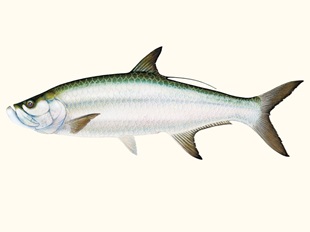|
There are two species of Megalops,
commonly known as
 the
tarpon, one native to the Atlantic, and the other to the
Indo-Pacific oceans. They are the only members of the family
Megalopidae and genus Megalops. the
tarpon, one native to the Atlantic, and the other to the
Indo-Pacific oceans. They are the only members of the family
Megalopidae and genus Megalops.
There are two species of Megalops, the Megalops atlanticus and the
Megalops cyprinoides. The Megalops atlanticus is found on the
western Atlantic coast from Virginia to Brazil, throughout the coast
of the Gulf of Mexico, throughout the Caribbean. It is also found
along the eastern Atlantic coast from Senegal to Angola. Megalops
cyprinoides is found along the eastern African coast, throughout
southeast Asia, Japan, Tahiti, and Australia. Both species are found
in both salt and freshwater habitats usually ascending rivers to
access freshwater marshes. They are able to survive in brackish
water, waters of varying pH, as well as habitats with low dissolved
O2 content due to their swim bladders which they use primarily to
breathe with.The habitat of the Megalops varies greatly with the
developmental stage they are in. Stage one larva are usually found
in clear, warm, oceanic waters relatively close to the surface.
Stage two and three larva are found in salt marshes, tidal pools,
creeks, and rivers. The habitats are characteristically warm,
shallow, dark bodies of water with sandy mud bottoms. It is quite
common for Megalops to ascend rivers into freshwater also. As the
progress through the juvenile stage to adulthood they move back to
the open waters of the ocean though many remain in freshwater
habitats as well.
Megalops grow to about 5-8ft. long and weigh 80-150lbs. They have
dorsal and anal soft rays and have a bluish or greenish back. They
possess distinctive lateral lines and have shiny silvery scales that
cover most of the organism except for the head. They possess large
eyes with adipose eyelids and a broad mouth with a prominent lower
jaw that juts out farther than the rest of the face.
Stage one developing Megalops do not forage for food but instead
absorb nutrients from sea water using integumentary absorption.
Stage two and three juveniles feed primarily on zooplankton but also
feed on insects and small fish. As they progress in juvenile
development, especially those developing in freshwater environments,
their consumption of insects, fish, crabs, and grass shrimp
increases. Adults are strictly carnivorous and feed on mid-water
prey; they swallow their food whole and hunt nocturnally.
One of the unique features of Megalops is the function of the swim
bladder as a psuedo-respiratory organ in Megalops. These gas
structures can be used for buoyancy, as an accessory respiratory
organ, or both. In Megalops, it is an unpaired air holding structure
that arrises dorsally from the posterior pharynx. Megalops utilizes
uses the swim bladder as a respiratory organ and the respiratory
surface is coated with blood capillaries with a thin epithelium
overtop. This is the basis of the alveolar tissue that is found in
the swim bladder and is believed to be one of the primary methods by
which Megalops “breathe.” Megalops are obligate air breathers, and
if they are not allowed to access the surface they will die. The
exchange of gas that occurs is done at the surface through a rolling
motion that is commonly associated with Megalops sightings. It is
believed that this “breathing” is mediated by visual cues and that
the frequency of breathing is inversely correlated to the dissolved
O2 content of the water in which they live.
Megalops are considered one of the great saltwater game fishes. They
are prized not only because of their great size but also because of
the fight that they put up and their spectacular leaping ability.
Megalops are bony fish and their meat is not desirable so most
Megalops are released after they are caught. There are numerous
tournaments around the year that are focused on catching Megalops.
Information courtesy of
Wikipedia
|